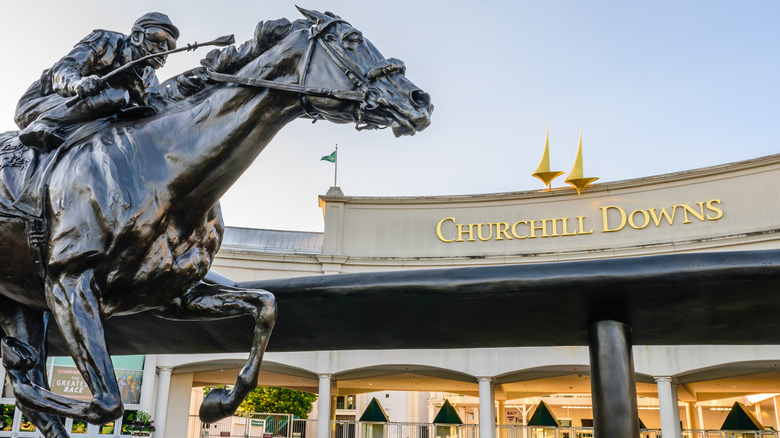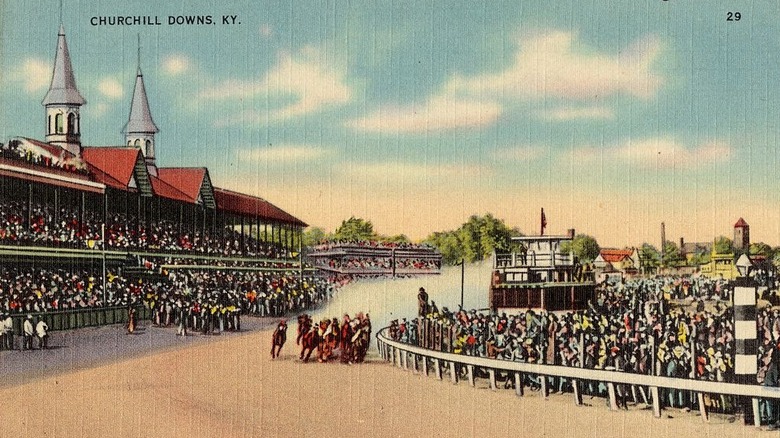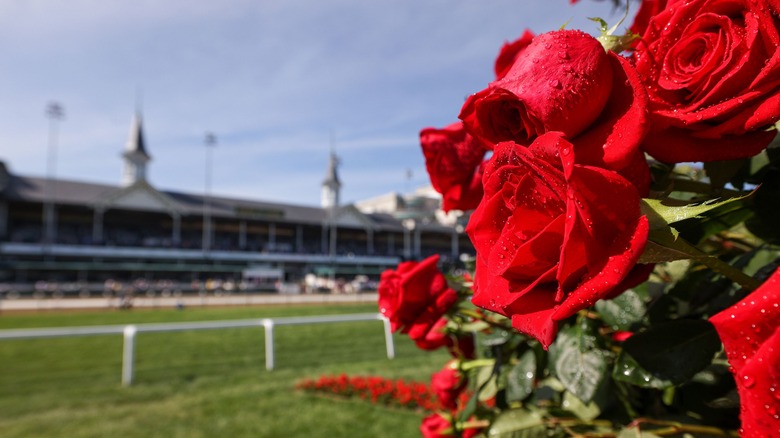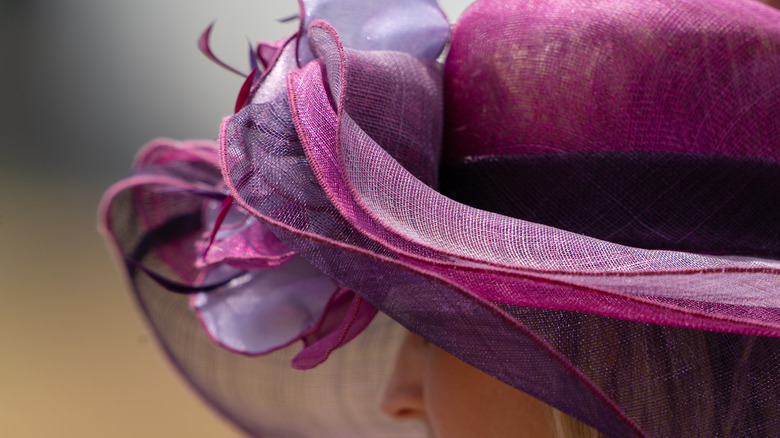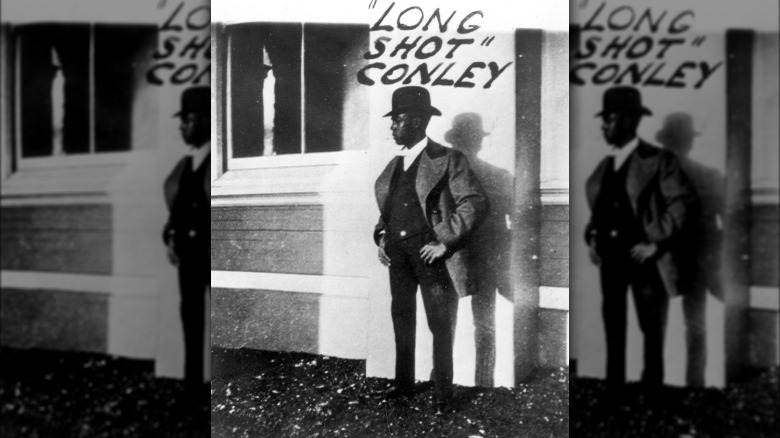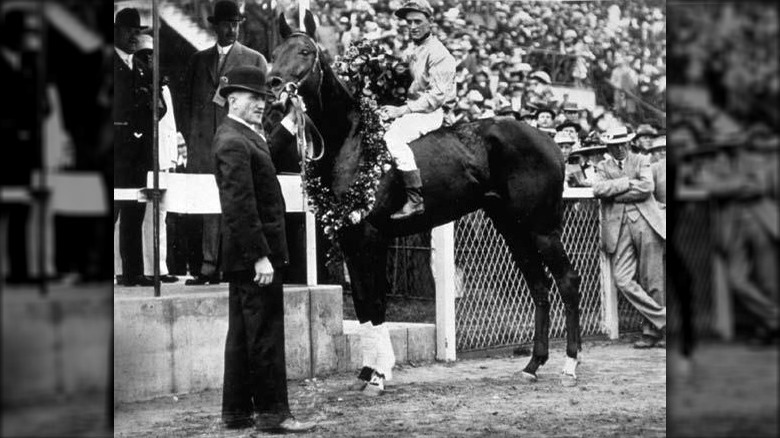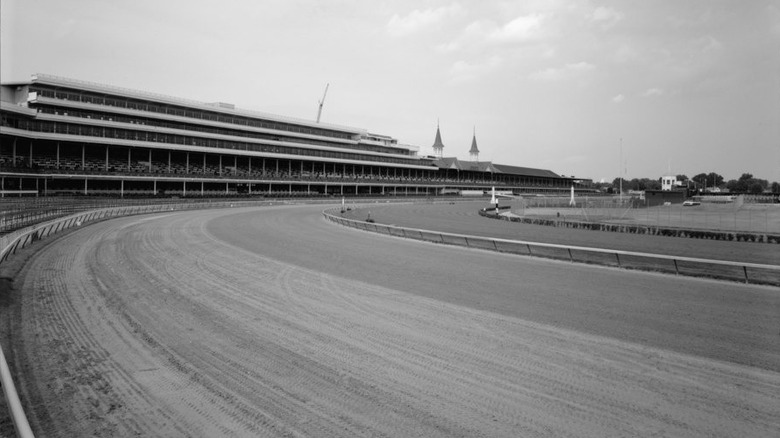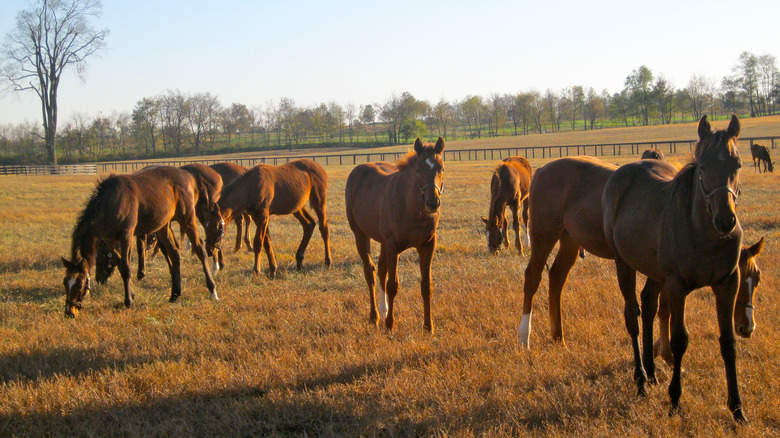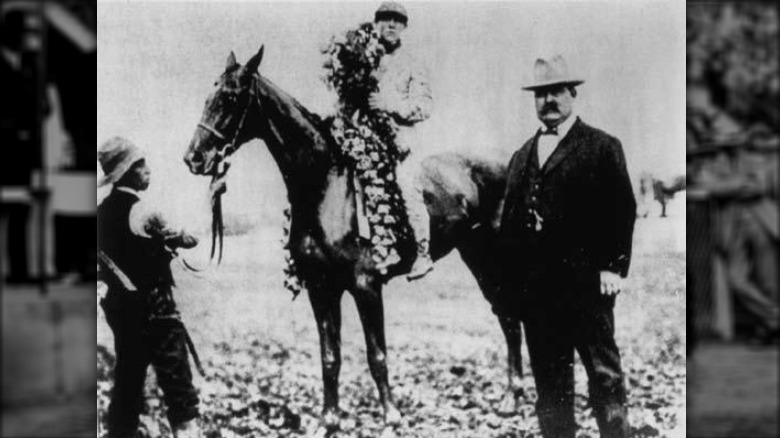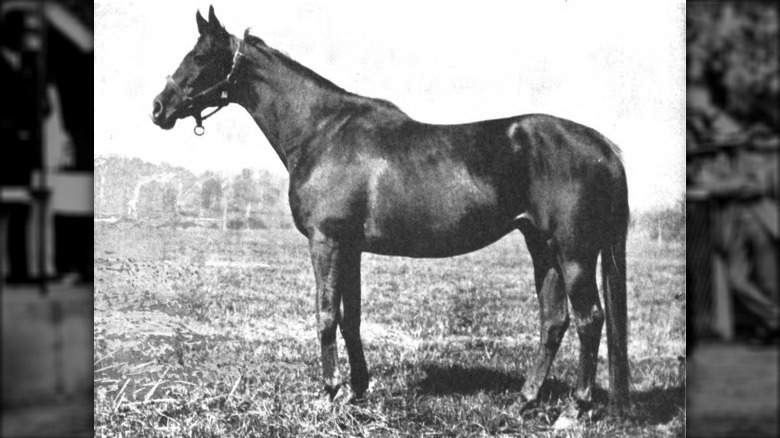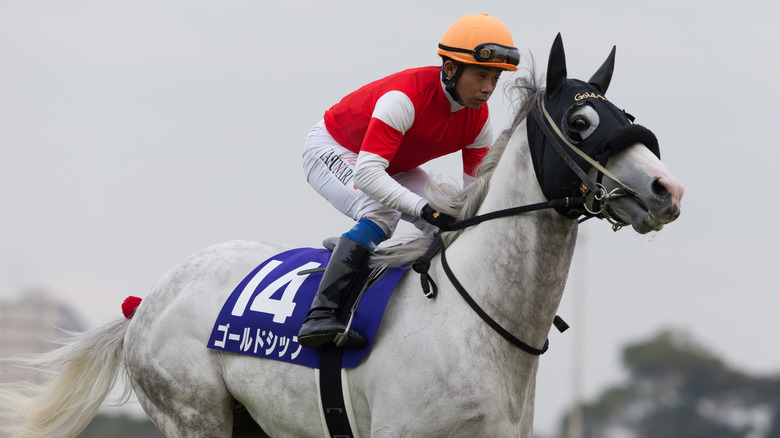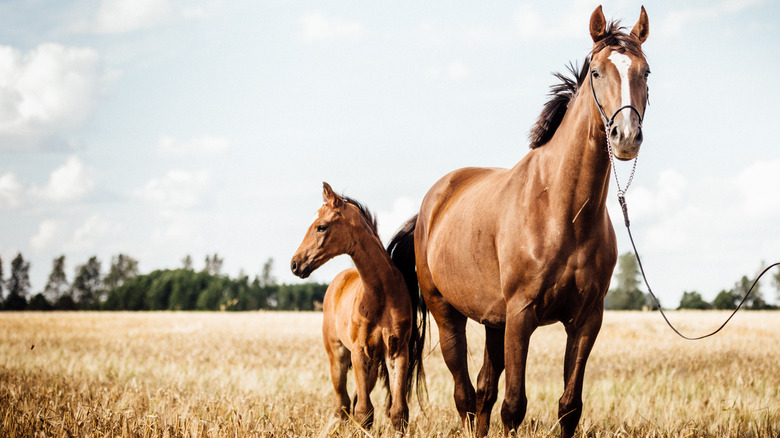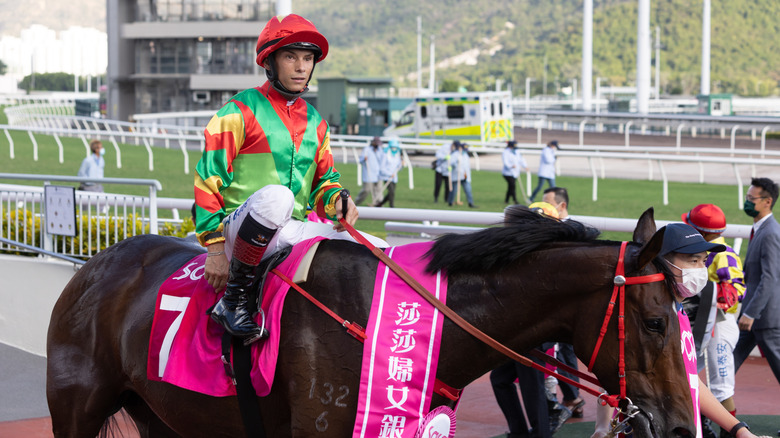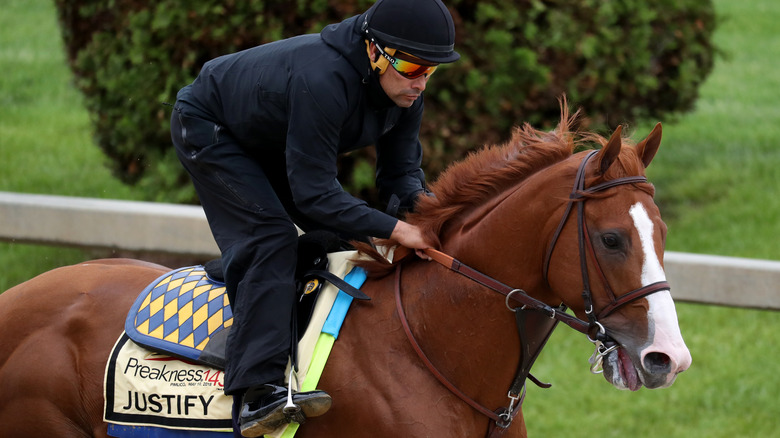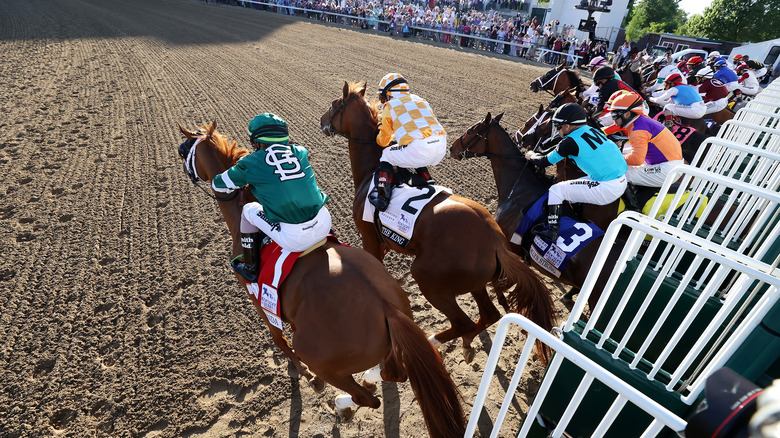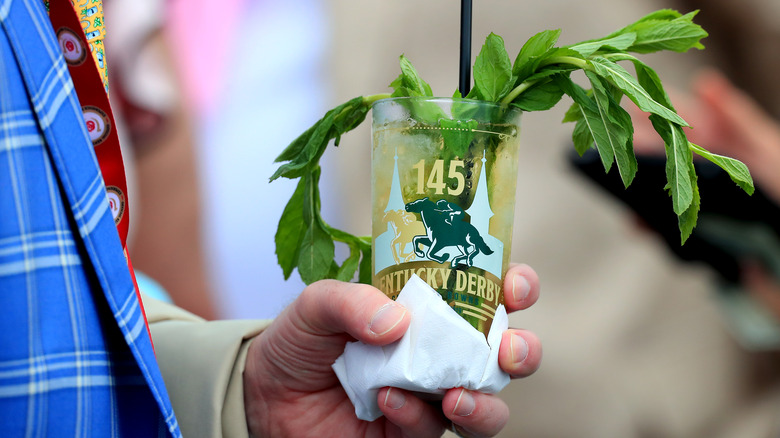15 Things You Might Not Know About The Kentucky Derby
You don't have to be a horse person to appreciate horse racing. What's not to love, besides the part where racehorses die all the time from stuff like broken legs, respiratory injuries, and multiorgan system failure (via National Geographic). If you can overlook that minor detail, though, there's the fancy hats, mint juleps, and a chance to lose thousands of dollars betting on the last place horse. Any way you look at it, a day at the races is exciting, even if you're just watching at home on television.
Still, you gotta admit, the enduring popularity of horse racing is a little hard to get your head around, especially when you consider that horses aren't really a part of popular culture like they used to be, and sports fans have lots of opportunities to watch much, much faster races (NASCAR, motorcycles, Indy cars, etc.) Maybe it's because horse racing is just so unlike any other sport (because, hey, how many athletes in other sports have to worry that their equipment will malfunction because an empty Starbucks bag fluttered into its peripheral vision?) Or maybe it's just because of the long, quirky, wonderful history of its most famous event: the Kentucky Derby. Here are a few things you might not have known about this century and a half-old American tradition.
The Kentucky Derby founder had a famous grandfather
You probably learned about the expedition of Lewis and Clark as a kid. At least you were supposed to, because for some reason teachers have never figured out how super-boring that stuff is to the average 10-year-old. Anyway, Meriwether Lewis and William Clark got a bunch of guys together and traveled into the wilderness, where they mostly just made maps and tried to convince the indigenous people that colonialism was totally cool. Seventy years later, Clark's grandson Meriwether Lewis Clark Jr. (you're not transposing words; he was named after his grandfather's travel companion) founded a horse race that people are still watching today.
According to History, Clark the younger not only founded the Kentucky Derby in 1875 but also built Churchill Downs, though neither one of those ideas was especially original. In fact, Clark was basically just copying Epson Downs in England, which was home to a nearly century-old race called the Derby Stakes.
Just in case you thought "derby" has always meant "horse race," it hasn't — the Derby Stakes was named for a person: The 12th Earl of Derby, so Clark wasn't even trying to be original when he picked the names "Churchill Downs" and "Kentucky Derby." He also borrowed the length of the race and the rules of entry from the Derby Stakes (1.5 miles, 3-year-old horses). Since the 12th Earl of Derby had died in 1834, he couldn't really be annoyed.
It's called the Run for the Roses because, um, women like flowers
Roses grow just fine in Kentucky, but it's not like they're the official state flower or anything. That honor goes to the goldenrod, though before the state flower was the goldenrod it was bluegrass (via KentuckyToday), hence Kentucky's nickname "the bluegrass state." No, according to legend roses became the official flower of the Kentucky Derby back in 1883 at an after-party thrown by New York socialite E. Berry Wall, also known as "King of the Dudes."
Now, you might be tempted to think "King of the Dudes" is a super awesome nickname, but it didn't mean the same thing in 1883 as it means today. Back then, a "dude" was a guy who was way too concerned with dressing fancy, so the nickname wasn't meant to be flattering, though Wall evidently owned it with pride (via the New York Sun).
Anyway, the King of the Dudes liked to throw parties and impress women, and at this particular party he was passing out roses to all the ladies. According to the Kentucky Derby's official website, Meriwether Lewis Clark Jr., who we've already established was not long on creativity, was impressed by how much all the ladies seemed to like their roses (or something), so he decided to make roses the official flower of the Kentucky Derby. In 1896, the related tradition of draping the winning horse with a blanket of roses was born.
Saved by antebellum culture
The Kentucky Derby plowed on through history until the mid-1890s, when it became clear that the iconic Kentucky racetrack was actually just a money pit. In 1894, the track was bought out by a group of investors who failed to make it profitable and then resold it to another group of investors in 1902. One of those investors was a tailor named Matt Winn because evidently tailors made a lot of money in those days and could afford to buy whole racetracks.
Anyway, Winn was largely responsible for defibrillating the nearly bankrupt Derby, and he basically did it by changing the whole vibe of the track and its famous race. According to the Derby Museum, Winn launched a publicity campaign designed to appeal to folks who missed the pre-Civil War glory days, you know, when women wore giant hoop skirts (fun fact: the New York Times once said hoop skirt fires killed like 40,000 people in the 1800s, per Martha Hall Kelly) and everyone pretended like slavery was Just Fine.
Well, there must have been a market for that sort of thing because his campaign worked. Shortly thereafter, the Derby became the strange costume party that it still is today, with everyone wearing ridiculous hats and drinking mint juleps. Who doesn't love to dress up, drink too much alcohol, and bet on the losing horse, right? It's a pretty simple formula, really.
The Kentucky Derby was once dominated by Black jockeys
There were 15 horses and 15 jockeys in the first Kentucky derby. Thirteen of those jockeys were Black. In fact, Black jockeys dominated the sport until 1902, when jockey Jimmy Winkfield rode the winning horse, Alan-a-Dale, across the finish line (via the Kentucky Derby). Can you guess why Black jockeys didn't ride in the Kentucky Derby much after that? Hint: It's not a trick question.
According to the National Bureau of Economic Research (NBER), in the 1880s, racetracks were pretty integrated places. By the 1890s, though, racism was turning the Derby into a hostile place, and Black riders were starting to feel a lot less welcome. The next-to-last Black jockey to enter the Derby before 2000 (the last was Henry King in 1921) was Jess Conley in 1911, who placed third on Colston, a Black-owned horse (via NPR).
There isn't really any official record of what ultimately led to the disappearance of Black jockeys, but according to NBER, a New York Times reporter recounted gossip that white jockeys had "organized to draw the color line," which basically means they asked horse owners and other influential people to shut Black riders out of the sport. The reporter even implied there was something of a conspiracy to sabotage Black riders. "Somehow or other," he wrote, "they met with all sorts of accidents and interference in their races. The doubting horse owners seem to have been convinced ... that if they want to win races they must ride the white jockeys."
The longest longshot winner in Derby history had 91-1 odds
Oddsmakers have a sort of formula that helps them decide which horses have the best chance of winning, but it's not as simple as just plugging some info into a computer. Oddsmaking also depends on the subjective analysis of human beings. According to BetHQ, people who watch horses in training, study racing forms, and are just general racing experts all have some input, and the odds also include variables like a horse's perceived ability, who the oddsmakers think the public might favor, how each horse runs, and what everyone thinks a horse's chances of winning will be.
Even with all those subjective variables, oddsmaking is much more of a science now than it used to be. Still, oddsmakers often get it wrong. In 2005, Giacomo was given 50-1 odds and won the race by a half-length, though to be fair, it was a pretty startling example of why horses that run too hard early in the race are usually doomed to lose. Giacomo bided his time at the back of the pack before charging ahead in the final seconds (via Seattle Times), but he was unable to repeat that performance in the second or third legs of the Triple Crown. Before that, though, a horse named Donerail defied his startling 91-1 odds to win the 1913 Derby. As of 2021, Donerail (pictured) still holds the record of longest-longshot to ever win the Kentucky Derby (via American Classic Pedigrees).
The Kentucky Derby is shorter than it used to be
If you're a Derby fan, you might have noticed that little factoid early on in this article about the race being 1.5 miles long and thought to yourself, "Wait, that's not right, the Derby is only 1.25 miles!"
Well actually, that little factoid is correct — for the first 21 years of the Derby's existence, the race was a grueling 1.5 miles. Today, only the Belmont Stakes is that long, and as the final leg of the Triple Crown, it's the longest race that any thoroughbred racehorse is likely to run in its career (via Kentucky Derby).
In 1896, it finally dawned on someone that maybe 1.5 miles was too much to ask of thoroughbreds that were barely past their third birthdays (via Kentucky Derby), so the distance was dialed back to 1.25 miles, which is the length it remains today. That change in distance is evident if you look back at the winning times across the race's history — before 1896, winning times rarely surpassed 2 minutes 37 seconds. Today, winners usually finish the race in an average of 2 minutes and 3 seconds (via USA Today Sports).
American horses rule (most of the time)
Over the long history of the Kentucky Derby, just about every horse that ever won was bred in the state of Kentucky. That's not super surprising, since horse breeding and racing is kind of a big thing in Kentucky, so it's really a numbers game more than anything. According to Horse Racing Nation, as of the 2021 Derby, 113 out of 147 Derby winners have been Kentucky born and bred.
Occasionally, horses that aren't Kentucky-bred do win the Derby, but those numbers lag way, way behind the bluegrass state. Florida, for example, has contributed six winners, and California and Virginia have each contributed four. It's even less common for horses born outside of the United States to win the Derby. In 1917, British-born Omar Khayyam won the Derby, but a non-U.S. native didn't win again until 1959, when British-born Tomy Lee finished first. Two Canadian horses (Northern Dancer in 1964 and Sunny's Halo in 1983) also broke the nationality barrier, but none since.
To be fair, Kentucky-bred horses might have a teensy advantage. According to HorsePlayUSA, the Kentucky Horse Racing Commission provides millions of dollars in incentives to Kentucky-bred horses that go on to win races. In 2021 alone, the program made $15.9 million available to bluegrass state breeders, and only bluegrass state breeders.
The slowest Derby winner was really, really slow
Everyone knows Secretariat has the fastest derby record. At 1 minute 59.40 seconds (via USA Today Sports), no other horse has really come close to beating the legendary thoroughbred. But who has the slowest win? Naturally, history remembers that, too, because history can't ever just look the other way and go, "Hey, maybe for the sake of not letting a humiliating memory last forever and ever in the eyes of the whole world we should just forget this ever happened?"
Happily, everyone who was associated with the embarrassingly slow Stone Street is long gone. In 1908, Stone Street (pictured) finished the race at 2 minutes 15.20 seconds, a whopping 16 seconds slower than Secretariat, and as of 2021, he still holds the record as the slowest Derby winner of all time — that is, since 1896 when the race was first shortened to 1.25 miles (via Horse Racing Nation). To be fair, the track was muddy and horses don't always run that well in those conditions, so there was at least a reason for the very slow win.
If you want to count the horses that ran the race when it was still 1.5 miles, the honor of slowest-ever winner goes to Kingman, who finished at 2 minutes 52.25 seconds. American Classic Pedigrees, though, says all four jockeys in that year's running had been told to keep it slow for the first mile, which made the whole race artificially sluggish.
Only three fillies have ever won the race
Stallions, geldings, and mares compete on pretty even footing in many equestrian sports. Gender doesn't matter that much for things like dressage, show jumping, and rodeo (via World of Showjumping) — winning in these sports is more about good training and good horsemanship than it is about gender. But in tests of pure speed, female horses aren't usually thought of as being competitive with male horses.
In the century and a half that the Kentucky Derby has been a thing, only three fillies have placed first: Regret in 1915 (pictured), Genuine Risk in 1980, and Winning Colors in 1988 (via Kentucky Derby). As of 2021, that's out of 40 filly competitors total (compared to a couple thousand or so colts), so the odds are stacked against them before they even leave the starting gate. Even so, it's not necessarily just gender bias that makes the pool so heavily favored towards colts. Trainer John Shirreffs told the LA Times that colts are better racing prospects partly because they like to "roughhouse," and American horse racing is a sport that includes a lot of jostling around on the track. This is different from horse racing in Europe, by the way, where fillies tend to be more competitive. Fillies also have a size disadvantage, so those that are competitive against colts are often larger than average.
Still, it's clearly possible for a filly to win, so don't discount the girls just 'cause they're girls.
Gray horses almost never win
Gray horses almost never win the Kentucky Derby, either. The reasons for this are a lot less mysterious, though. It's not because gray horses are somehow fundamentally less fast than bays and chestnuts, it's just because there aren't as many of them.
In the most recent 108 Kentucky Derbies up until 2021, there were eight gray winners. That's compared to 48 chestnut victors and 56 bays (via the Courier-Journal). If you want to go by percentages, this means about half of recent Derby winners have been bays, 43% have been chestnuts, and 7% have been grays. According to CNN, though, it's really just about genetics. In the U.K., for example, only around 3% of all thoroughbreds registered in 2011 were gray. Chestnuts, on the other hand, made up about 20% of the registrants, with bays having a numbers advantage of 73%, which means more bays and chestnuts win simply because there are more bays and chestnuts. So if you want to look at it based on numbers, bays have been underperforming at the Kentucky Derby, chestnuts have been overperforming, and grays have done more than twice as well as might be expected.
So the moral of the story is, don't bet against the gray horse because it's gray. Just like human beings, color has nothing to do with ability.
Only 12 Derby winners have gone on to sire other winners
It's tempting to assume that greatness always begets greatness, especially since we are used to seeing the sons and daughters of talented people go on to demonstrate similar talents in similar careers. But with horses, it's not really that simple. Owning a horse that was sired by a Kentucky Derby winner is not a sure bet that one day that horse will also be a Kentucky Derby winner.
Lots of different things go into making a horse great, and it's not just genetics — training, the skill of the horse's jockey, and frankly, how much money you've got to put into all of that are all just as important as who the horse's sire is. Just to prove this point, in the 147-year history of the Kentucky Derby (up until 2021), only 12 Kentucky Derby winners have gone on to sire Kentucky Derby winners (via Horse Racing Nation). That's actually not a super great track record, and frankly, it even seems like it could have as much to do with chance as anything.
Even the great Secretariat didn't produce any notable sons or daughters. According to History, not one of his 600 foals had an especially impressive racing career (though he did have a great-granddaughter who won the Belmont Stakes). That alone should be enough to prove that "like father, like son" doesn't really apply to thoroughbreds.
Female jockeys are way, way underrepresented
Just as female horses are underrepresented in the Kentucky Derby, so are female jockeys. That's actually more surprising than the absence of fillies on the race track just because women have a lot of natural qualities that make them exceedingly well-suited to be jockeys. For example, jockeys tend to be small, and there are many more small women than small men. Women also tend to be more drawn to horses than men — in fact according to Statista, roughly 90.8% of all American horse owners and managers are women. Women are excellent riders and proven athletes, and there's absolutely no reason why they should not be better represented at horse races like the Kentucky Derby. And yet, they aren't.
According to USA Today, the first woman to ride in the Kentucky Derby was Diane Crump in 1969, and male jockeys were about as happy about her participation as you might imagine male jockeys would have been back in 1969. None of their predictions about her general fitness to compete turned out to be true, of course, but since then the numbers have remained abysmal. Only five other women have ridden in the Derby.
Unlike with fillies, though, this isn't about capability, it's about numbers (once again). Women can ride as well as men, it's just that there aren't as many opportunities for them to participate. If the field was more 50-50, it's unlikely the Kentucky Derby's winner's circle would be so male dominated.
The Derby has never been canceled because of weather
If you've ever been to Kentucky, you know the weather is pretty okay. Summer temperatures range in the high 80s, and winter temperatures drop down to the 20s (via Best Places). That makes the bluegrass state a good place to have a horse race, especially since average temperatures in May are usually in the mid-70s. Mother Nature doesn't pay a whole lot of attention to averages, though. The temperatures on Derby day have ranged from a high of 94 degrees to a low of 36 (via the Twinspires Edge).
Temperature alone isn't usually enough to red- or green-light a sporting event like the Kentucky Derby, but you might imagine rain would be. And yet, the Kentucky Derby has never been canceled because of rain (or for any other reason), even though there have been some ridiculously rainy race days and/or race days where previous days' rain left the track muddy and difficult for the horses to run on. Stone Street's infamously slow race was a run on a muddy track, and the U.S. Weather Service says around 3.15 inches of rain came down during the 2018 running, making it the wettest race on record. Still, the race went on despite the torrential downpour, which probably ruined more than a few fancy hats and the chances of more than a few horses unaccustomed to running in those conditions. That year, Justify (pictured) won the Derby with a so-so time of 2 minutes 4.20 seconds.
Post 1 is unlucky, and post 5 is the luckiest
Most athletes are at least a little superstitious. Some athletes are a lot superstitious. Horse racing, for whatever reason, seems to be one of the more superstitious sports. The color green, for example, is largely thought of as unlucky in racing circles (via Bloodhorse).
Some racing superstitions have at least a little basis in fact, though. Post number 1, for example, is one of the most unlucky posts, but according to the Kentucky Derby, that's at least partly because a horse that breaks from that position tends to get crowded on the inside of the track. Posts 2, 9, 12, 14, and 17, however, are even less lucky (the last time a horse won from post 14, for example, was in 1961). That's a little harder to explain.
Post 5, on the other hand, is one of the luckiest. Ten horses breaking from post 5 have gone on to win the Derby. It's not clear why, though it's probably a safe bet that it has at least something to do with the fact that there haven't been enough Derbies to provide a decent statistical picture of the winningness of each particular gate. You never know, though, maybe some posts are just cursed. Or more likely, jockeys are just superstitious enough to get a little mental boost from being lucky enough to start from post 5, and that by itself is enough to give them the edge.
Churchill Downs sells 120,000 mint juleps every year
Finally, the question everyone has been waiting for. The most important piece of trivia related to the Kentucky Derby. The one that matters the most. How many mint juleps does Churchill Downs sell every single year?
The answer: 120,000 (via the Kentucky Derby). That's right, 12% of 1 million mint juleps every single year. Now let's extrapolate from that how many mint juleps that is per person, and, well, it's actually less than one. On average, the Kentucky Derby says around 150,000 people are in attendance each year. Some of those people are likey to be under the age of 21, though, so let's just say it's an average of one per legal drinker. That means most people who watch the Kentucky Derby are at least one cocktail from sober, and that is just as well because when you bet on the losing horse, you need all the extra help you can get.
